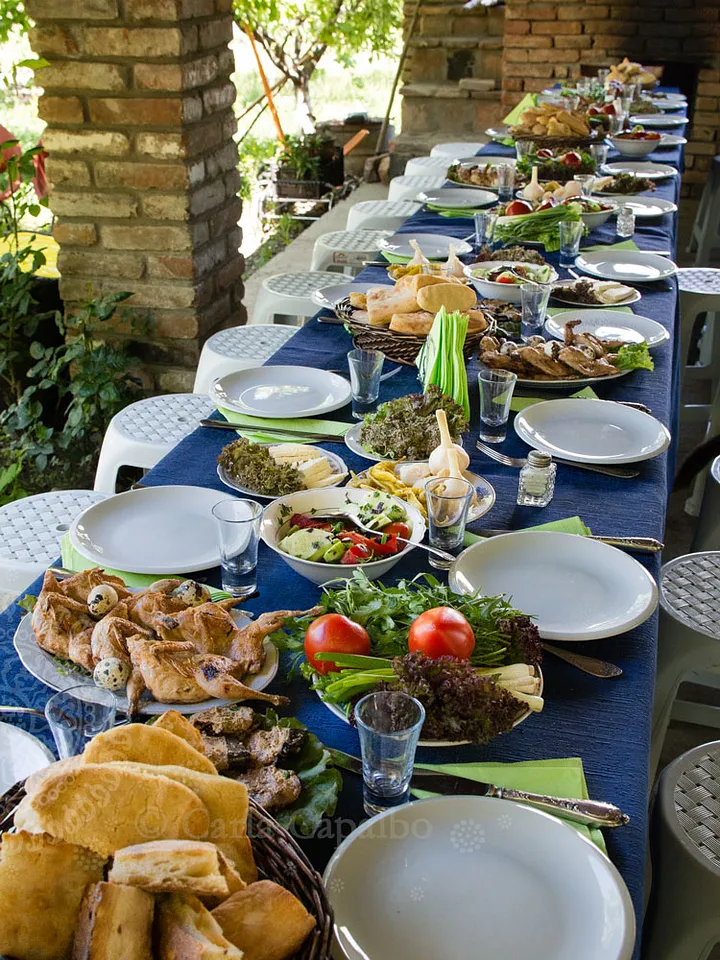A culture of feasting

ANDY NEATHER 31 JAN 2024

GEORGIAN food is about sharing. Different dishes fill the table at a supra (feast) with everyone helping themselves: it’s an intensely social food and wine culture. Yet it remains relatively little known beyond the old Soviet empire: what the legendary chef of Copenhagen’s Noma, René Redzepi, has called “one of the last undiscovered great food cultures of Europe”.So what happens when you try to turn it into a London bistro experience? That was the challenge embraced last month by new Charlotte Street Georgian restaurant Kinkally.Kinkally’s succinct menu is focussed on small plates involving classic Georgian elements such as zucchini pkhali (balls or spread of chopped vegetables) with walnuts; imeruli khachapuri (cheesy pide-like bread); beetroot with tkemali (sour plum sauce) and mint; and on the eponymous khinkali, stuffed dumplings made of twisted dough. With all this the restaurant offers three Georgian wines. There’s also a nice bar downstairs serving notably good cocktails with Georgian twists.It’s certainly tasty – but is it authentically Georgian? I recently sat down at the Kinkally chef’s counter with Carla Capalbo, author of Tasting Georgia: A Food and Wine Journey in the Caucasus (2017) – probably the best book in English on Georgian cuisine. Her travels illustrate the surprising diversity of this small country of four million people, from high valleys in the Caucasus mountains to the subtropical Black Sea coast, with a corresponding range of local specialities. It’s a proud culture, reinforced by a complex relationship with its huge Russian neighbour to the north: not for nothing is “Cheers!” in Georgian, Gaumarjos! (“Victory to you!”)Capalbo has been visiting Georgia for a decade and is a demanding judge: of Kinkally’s khachapuri, she commented, “This is good but it doesn’t have the right cheese.” Her judgment on the khinkali of wagyu beef with peppercorn plum sauce and svanetian salt: “This is steak au poivre in a dumpling. It doesn’t taste Georgian but it’s lovely.”But Capalbo enjoyed all the food – and wines. The orange Lagazi Rkatsiteli wine made in qvevri (the classic Georgian method, an earthenware, egg-shaped amphora buried up to its neck in the ground and sealed) was a little funky for my tastes. But she cautions that at a supra, “the range of flavours on the table, from sour plum to spicy adjika [chilli paste or dip], herbs and so on - these wines and their tannins are the only ones that can stand it. You put a Sauvignon Blanc next to it and it’ll die in a minute.”Georgians are immensely proud of their country being the cradle of winemaking: 8,000-year-old qvevri have been found by archaeologists. The wine is for another blog post: but while almost unknown in Britain a decade ago, like Georgia’s food, its wines have been gradually gaining profile. And wine is integral to the Georgian food experience.This was why Richard and Eka Cox’s hobby business of importing Georgian wine turned into an East Dulwich Georgian restaurant, Kartuli, in October 2020: “without food, wine’s not very Georgian,” explains Eka. They now sell probably the largest range of Georgian wines in London, as well as traditional spirits such as the lethal Chacha (grappa). They operate as a wine shop too.Kartuli isn’t as sleek as Kinkally: it’s homely, located in a charming former store in the long-defunct David Greig grocery chain. Capalbo confirms the food’s authenticity. But while I’ve heard Georgian being spoken by other diners here on a couple of occasions, Eka Cox says that no more than 15 per cent of their clientele is from the country. That means convincing south Londoners to embrace the supra experience – something evidently best done if there’s a group of you.With small plates now well established in our restaurant culture via mezze and tapas, that’s not such a cultural leap. Not all the dishes aren’t in fact so small, though. Take the many traditional breads: adjaruli khachapuri, the best known, is a long boat shape with a raw egg and melted butter added to the melted cheese: sinfully good, though it can add up to a challenging spread. “Georgians have a bigger appetite than English people”, shrugs Eka.The majority of the capital’s small Georgian diaspora live in north London, which is where most of the restaurants are. At Little Georgia, a busy neighbourhood restaurant in Barnsbury, I enjoyed huge, succulent mtsvadi – roast pork kebabs – with plum sauce, cut with salad and the signature Georgian walnut sauce in the dressing (I couldn’t resist polishing off an adjaruli khachapuri too.) Nearby Tbilisi, one of the longest-established London Georgian joints, is a little more sedate but offers a good food and wine selection: I enjoyed their chakapuli – lamb shank stewed in white wine with tarragon and other herbs.Sitting watching the chefs at Kinkally, Carla and I finished our lamb, adjika and sesame khinkali and decided we didn’t have room for the dessert of matsoni (a kind of yoghurt) cream with lemon and halva that I’d enjoyed on another occasion here. A fascinating excursion into Georgian flavours – but my first full-scale supra still awaits me.



